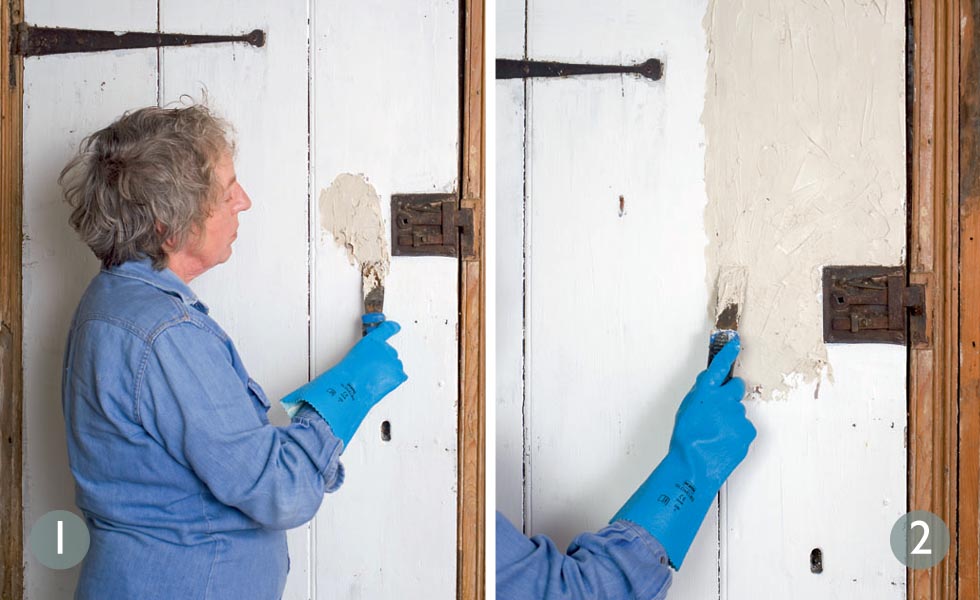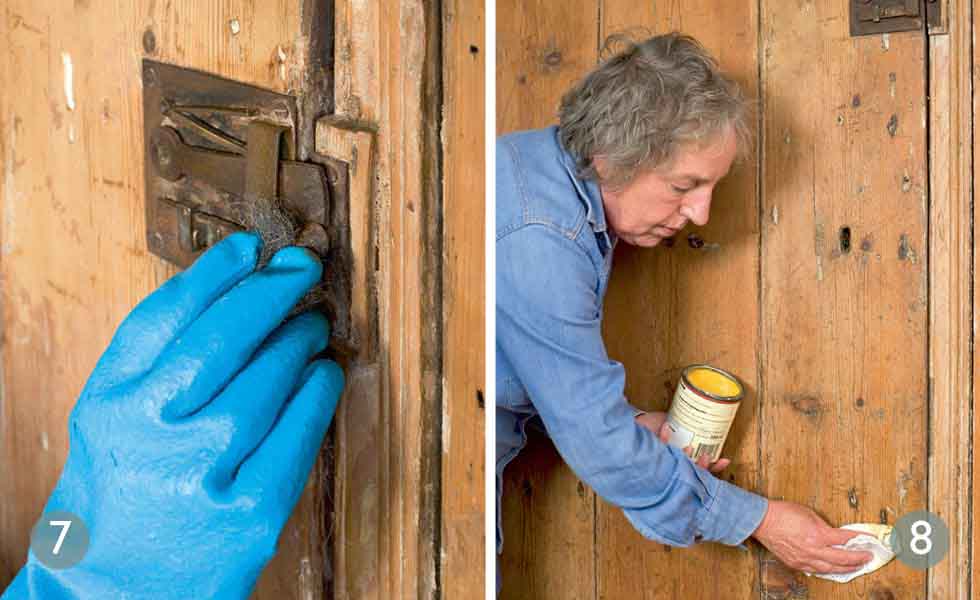How to remove paint from wood – with or without chemicals, or vinegar
You can remove paint from wood doors, floors, trim and more with or without chemicals and using vinegar to help. Ideal to add a new stain or to revive old woodwork.

Stripping paint from wood can be a time-consuming and messy job. Whether you're planning to work on wooden floors, trim or a door.
There are a couple of different reasons why you'd want to know how to remove paint from wood in the first place. And, it's usually because you want to change the finish of the wood with a stain, or revive the look of a room altogether with another achievable DIY project. It's important to make sure the wood is worthy of the effort before you get started. So if inferior timber was used originally, or if it’s an unsightly mass of worm-holes, it might not be a good idea to strip paint from the wood after all.
You may need to remove paint prior to painting trim and other molding. Note that 'If you will be merely painting over the wood again, you do not need to 100% remove the existing paint from the wood in order to re-paint it.' Says Paige of CertaPro Painters of the South Shore and Boston. 'If this is the case, Paige recommends you simply 'Sand areas where paint might be peeling to a point where the paint no longer is peeling off. Use wood putty on any holes and sand those to a smooth finish. Prime any spots of bare wood showing through. Paint a finish coat or two. Usually on wood trim we paint using a semi-gloss paint, but the sheen is a personal choice.'
'Completely removing paint from wood is very labor intensive and therefore is usually only considered in high visibility places like a beautiful wooden front door where you visitors will be able to see, up close, the fruits of this very laborious process. It’s understood that the wood you’re stripping is worth seeing underneath and that you’d likely be staining the exposed wood so you can see the wood grain.' Continues Paige.
What is the best way to remove paint from wood?
Removing paint from wood with chemical stripper
If you are working on a larger surface like a painted door, trim or furniture, Travis Nolan, Founder of Old Crow Painting says 'The safest way to remove paint from wood would be chemically stripping, considering there are lots of different types of finished materials that could be present on the item, you'll want to test multiple strippers in a small area on that item to see which stripper works the best.'
Removing paint from wood without chemicals
Get small space home decor ideas, celeb inspiration, DIY tips and more, straight to your inbox!
Vineta Jackson, Owner and Founder of The Handyman's Daughter says 'The best way to remove paint from wood is with a chemical stripper. If you don't want to deal with harsh chemical fumes, there are products made from natural ingredients that work great. I highly recommend Blue Bear paint and urethane stripper, which is made from soybeans and doesn't have any odor. Others may recommend Citristrip, which is made from citrus, but many people find the orange scent overwhelming.' Some also use vinegar to help, more on this below.
Removing paint from wood with a hot-air gun
Some people favor a hot-air gun to strip paint; use it just enough to soften but not burn the paint. Keep the thermostat set below 450°C to avoid giving off fumes. Gloss paint manufactured before the mid 1960s contained a small quantity of lead, so if you’re unsure (you can buy a lead testing kit), use a paint stripping method that doesn’t create dust. Once the main job is done, don’t use sandpaper to get rid of the residue; instead moisten the surface and smooth it with wet waterproof abrasive paper.
Removing paint from wood by sanding
Some use the sanding method as a way to remove paint from large flat surfaces but this is best left for outside work as it can be quite an ordeal, especially if you're stripping lead-based paint. We'd recommend you hire a professional for that kind of job. Paige adds 'Make sure there you are not removing lead paint from the wood. Lead paint is toxic and if it is lead paint, you need to call a painter with an RRP license to do the job. These types of painters will do very little to disturb the lead, choosing not to aggressively sand the lead paint to let the paint chips disperse willy-nilly.'
Does vinegar remove paint from wood?
Vinegar will not remove paint from wooden furnishings but it will soften it making it easier to remove with scrubbing. Nolan adds that 'Denatured alcohol will remove latex paint in small quantities.'
'I’d suggest using vinegar if you see drips of paint on your floor and simply want to loosen them before you gingerly scrape them off.' Adds Paige.
What you will need to strip paint from wood:
- Paint stripping product such as Citristrip or a soy based alternative
- Protective plastic floor sheet
- Plastic covering such as plastic wrap or bin bags
- Spreading knife
- Scrubbing brush
- White vinegar and sponge
- Medium grade steel wool
- Fine grade glasspaper
- Liquid beeswax for wood
- Good quality wax furniture polish
- Heavy duty work gloves
How to remove paint from a wood door
Here, we tackle a door, but the same principles apply to floors and furniture.
- Before you start: Be sure to clear the surroundings first, and protect the floor with a plastic sheet. Never strip paint without wearing heavy duty work gloves. Keep children and animals away from the area during and after stripping paint.
1. Patch test the paint stripper solution
Before you start to strip paint from wood, carry out a test on a small area of the wood. At the top apply a thick layer of stripper tapering down to a thinner layer at the bottom. Cover and leave. You will then be able to judge how thickly you need to apply the product and how long you will need to leave it.

2. Apply the stripper to the paint
Once you know how thickly the paint stripper must be applied in order to lift off all the layers, the next step to successfully strip paint from wood is to spread it over the entire surface. A wide, slightly flexible scraper is ideal for the job.
'Once you have found the best stripper material, apply a generous amount to your finished surface to be stripped. We want it to stay as saturated as possible.' Adds Nolan.

3. Leave the paint to dissolve
Cover the stripper with plastic or bin liners to keep it moist and stop it drying out. The paste will slowly dissolve the paint to a water-soluble residue. This could take between 15 minutes to several days, depending on the thickness of the paint layers. One application can dissolve a very thick layer of paint if given enough time to do so.
'After you've done an area or the entire side of the door, for instance, you'll then cover it with plastic to let it sit and let the stripper work while checking on it every 10 to 15 to see if you're able to begin scraping.' Adds Nolan.
Jackson actually recommends you leave a thick coat of stripper on for at least half an hour.
4. Clear away the paste and paint
You’ll know the paste has done its job when you take off the plastic covering and the softened paint peels away from the door. Immediately stuff the plastic and dissolved paint safely in a bin bag and tie the top just in case there’s any old lead in there.

5. Scrub away residue with water
Once the bulk of the paint stripper and dissolved paint has been removed, residual paint can be cleaned away with a scrubbing brush and warm water or even just damp towels if it's soft enough. Wipe away loosened paint with a sponge. When you’ve finished, mop up surplus water with an old towel, otherwise it may raise the grain of the wood.
'Then using various tools, scrap off all that you can without damaging corners or detailed spots. Wiping it down with Acetone to remove any excess product.' Says Nolan.
'Test the paint after 30 minutes to see if it peels off easily. You should be able to scrape it off with a putty knife without scratching the wood underneath. A scrub brush should help get the paint out of all the nooks and crannies until the surface is clean.' Adds Jackson.
6. Wipe away any salty deposits
Wait until the wood is completely dry. If efflorescence has occurred – white crystalline salty deposits – brush them off and rinse the surface again. Neutralise the wood by sponging it down with a solution of one part white vinegar to three parts water. Allow to dry thoroughly before applying any finishes.
'After it is completely dried and free of the old coating and stripper then you can begin sanding using various sanding grit, going between 80 and 120 grit.' Nolan adds.
Top tip: After stripping paint with a chemical stripper, you must always neutralize the wood with white spirit or white vinegar depending on the product. Forget to do this and you may find a bloom developing under the finish, or a subsequent coat of paint or varnish will fail to bond.

7. Spruce up door furniture
Once you’ve made the effort to strip paint from wood, particularly a door or window, and return it to its beautiful natural finish, you may find the door/window furniture no longer does it justice.
Dip medium grade steel wool in oil and rub away rust deposits; this will also protect it from future corrosion. A few drops of oil on the hinges will put paid to squeaks and creaks. Tighten any loose screws.
8. Smooth and nourish the wood
Smooth the wood with fine grade glasspaper following the grain. To nourish the wood and protect it from the drying effect of central heating apply a finish of liquid beeswax by brush or cloth. Leave for six hours and apply more coats as necessary. Once dry buff with a cotton cloth and for extra shine apply wax polish.
How do you get paint off wood without damaging it?
Nolan says, 'My professional recommendation would be to take the time and strip it off or you can use high grade equipment such as festool and / or Metabo paint remover power tools. There are various styles of scrapers online that can help aid in this process.'